Carbon sink capacity in northern forests reduced by global warming
 An international study investigating the carbon sink capacity of northern terrestrial ecosystems discovered that the duration of the net carbon uptake period (CUP) has on average decreased due to warmer autumn temperatures.
An international study investigating the carbon sink capacity of northern terrestrial ecosystems discovered that the duration of the net carbon uptake period (CUP) has on average decreased due to warmer autumn temperatures.This seems counter-intuitive: warm autumns surely imply long growing seasons and a beneficial effect on terrestrial carbon sinks as trees and plants make more biomass. However, an explanation is provided by satellite observations and numerical modelling which shows that enhanced respiration caused by higher temperatures causes carbon losses that offset photosynthetic gains, limiting the potential of these ecosystems to act as carbon sinks. The findings were published as the lead article in the January 3 issue of Nature.
The carbon balance of terrestrial ecosystems is particularly sensitive to climatic changes in autumn and spring. Over the past two decades autumn temperatures in northern latitudes have risen by about 1.1 °C with spring temperatures up by 0.8 °C.
 Many northern terrestrial ecosystems currently lose carbon dioxide (CO2) in response to this autumn warming, offsetting 90% of the increased carbon dioxide uptake during spring. Using computer modeling to integrate forest canopy measurements and remote satellite data, the researchers found that while warm spring temperatures accelerate growth more than soil decomposition and enhance carbon uptake, autumn warming greatly increases soil decomposition and significantly reduces carbon uptake (graph, click to enlarge).
Many northern terrestrial ecosystems currently lose carbon dioxide (CO2) in response to this autumn warming, offsetting 90% of the increased carbon dioxide uptake during spring. Using computer modeling to integrate forest canopy measurements and remote satellite data, the researchers found that while warm spring temperatures accelerate growth more than soil decomposition and enhance carbon uptake, autumn warming greatly increases soil decomposition and significantly reduces carbon uptake (graph, click to enlarge).Lead author of the study, Dr. Shilong Piao from the LSCE, UMR CEA-CNRS in France says that if warming in autumn occurs at a faster rate than in spring, the ability of northern ecosystems to sequester carbon will diminish in the future:
 biofuels :: energy :: sustainability :: biomass :: bioenergy :: forests :: carbon sink :: carbon cycle :: climate change :: Northern hemisphere ::
biofuels :: energy :: sustainability :: biomass :: bioenergy :: forests :: carbon sink :: carbon cycle :: climate change :: Northern hemisphere :: Philippe Ciais also, a member of the research team and a scientist from the Global Carbon Project says the potentially rapid decline in the future ability of northern terrestrial ecosystems to remove atmospheric carbon dioxide would make stabilization of atmospheric CO2 concentrations much harder than currently predicted.
 The study was supported by European Community-funded projects ENSEMBLES and CarboEurope-IP, and by the National Natural Science Foundation of China as well as by Fluxnet-Canada, which was supported by CFCAS, NSERC, BIOCAP, MSC and NRCan.
The study was supported by European Community-funded projects ENSEMBLES and CarboEurope-IP, and by the National Natural Science Foundation of China as well as by Fluxnet-Canada, which was supported by CFCAS, NSERC, BIOCAP, MSC and NRCan.The ENSEMBLES project is supported by the European Commission's 6th Framework Programme as a 5 year Integrated Project from 2004-2009 under the Thematic Sub-Priority "Global Change and Ecosystems".
It aims to:
- Develop an ensemble prediction system for climate change based on the principal state-of-the-art, high resolution, global and regional Earth System models developed in Europe, validated against quality controlled, high resolution gridded datasets for Europe, to produce for the first time, an objective probabilistic estimate of uncertainty in future climate at the seasonal to decadal and longer timescales
- Quantify and reduce the uncertainty in the representation of physical, chemical, biological and human-related feedbacks in the Earth System (including water resource, land use, and air quality issues, and carbon cycle feedbacks)
- Maximise the exploitation of the results by linking the outputs of the ensemble prediction system to a range of applications, including agriculture, health, food security, energy, water resources, insurance and weather risk management
Innovation
The key innovation of the CarboEurope-IP is in its conception as to apply single comprehensive experimental strategy, and its integration into a comprehensive carbon data assimilation framework. The observational and modelling programme will run at unprecedented spatial and temporal resolution. This will allow for the first time a consistent match of bottom-up and top-down estimates of the regional variation in carbon sources and sinks.
Graph: A total of 108 site-years have been aggregated in this figure. The average (blue) and median (green) anomaly of ending date of net CUP is shown for different autumn temperature anomalies binned into 0.5 °C intervals. The top horizontal axis labels correspond to the number of site-years and sites (in parenthesis) in each temperature bin. The bottom left inset shows the relationships between ending date of CUP and temperature anomalies. There is a marginally negative correlation between autumn CUP ending date and temperature anomalies (y = -1.7x - 0.0087, P = 0.07). If we exclude the four site-years with the most extreme cold anomalies (DeltaT < -2 °C), the negative correlation between CUP ending date and temperature becomes highly significant (P = 0.03) and the slope is steeper (y = -2.4x + 0.3007), suggesting that below a certain threshold of cold anomaly there is no further decrease in respiration. The top right inset shows the relationships between autumn NEP and temperature anomalies. A positive NEP value indicates an increased carbon uptake. Autumn was defined as the 60-day interval around the average CUP ending date for each site. Eddy-covariance data show increased carbon losses under warmer conditions, with a temperature sensitivity of NEP of -3.2 g C m-2 °C-1 (y = -3.17x - 5 times 10-6, P = 0.04).Credit: Shilong Piao, et al.
Map: (a) ORCHIDEE model-derived autumn GPP. (b), ORCHIDEE model-derived autumn NPP. (c), ORCHIDEE model-derived autumn NEP. (d), Sum of satellite-derived autumn normalized difference vegetation index (NDVI). The sensitivity is expressed as the linearly regressed slope of autumn carbon flux or of NDVI against autumn temperature for each pixel over the past two decades. A positive slope of NEP indicates that terrestrial carbon uptake is increasing with warmer temperatures, and vice versa. Areas with a low sensitivity or insignificant (P > 0.05) relationships between the variables are coloured in grey. Credit: Shilong Piao, et al.
Image: Tour-Bluets - Flux tower on a recently harvest boreal black spruce site with lowbush blueberry ground cover, Chibougamau, Quebec.Credit: Onil Bergeron.
References:
Shilong Piao, Philippe Ciais, Pierre Friedlingstein, Philippe Peylin, Markus Reichstein, Sebastiaan Luyssaert, Hank Margolis, Jingyun Fang, Alan Barr, Anping Chen, Achim Grelle, David Hollinger, Tuomas Laurila, Anders Lindroth, Andrew D. Richardson & Timo Vesala, "Net carbon dioxide losses of northern ecosystems in response to autumn warming", Nature, 451, 49-52 (3 January 2008) | doi:10.1038/nature06444
Eurekalert: Carbon sink capacity in northern forests reduced by global warming - January 2, 2008.
ENSEMBLES project website.
CarboEurope-IP project website.
Article continues
 --------------
--------------
 Scottish and Southern Energy plc, the UK's second largest power company, has completed the acquisition of Slough Heat and Power Ltd from SEGRO plc for a total cash consideration of £49.25m. The 101MW CHP plant is the UK’s largest dedicated biomass energy facility fueled by wood chips, biomass and waste paper. Part of the plant is contracted under the Non Fossil Fuel Obligation and part of it produces over 200GWH of output qualifying for Renewable Obligation Certificates (ROCs), which is equivalent to around 90MW of wind generation.
Scottish and Southern Energy plc, the UK's second largest power company, has completed the acquisition of Slough Heat and Power Ltd from SEGRO plc for a total cash consideration of £49.25m. The 101MW CHP plant is the UK’s largest dedicated biomass energy facility fueled by wood chips, biomass and waste paper. Part of the plant is contracted under the Non Fossil Fuel Obligation and part of it produces over 200GWH of output qualifying for Renewable Obligation Certificates (ROCs), which is equivalent to around 90MW of wind generation.










Thursday, January 03, 2008
Chinese auto maker Dongfeng to develop dedicated hydrous ethanol engines
Present ethanol-fueled vehicles need anhydrous or 'absolute' ethanol blended with gasoline, that is, ethanol containing almost no water (less than 1%). But dewatering hydrous ethanol to obtain a purer fuel is typically an energy intensive and costly process that involves adding large amounts of heat (previous post). Ethanol and water form a 95% azeotrope so it is not possible to reach 100% by simple distillation. Further purification processes consist of desiccation using glycerol, adsorbents such as starch or zeolites, as well as azeotropic distillation and extractive distillation. All these dewatering techniques lower the energy balance of the fuel.
Experts at the China Association of Automobile Manufacturers say that producing hydrous ethanol containing only 65 percent ethanol would consume up to 60 percent less energy compared with producing the same amount of pure ethanol.
According to Dongfeng, the use of this hydrous ethanol, unlike some synthetic (bio)fuels that require adapted engines, only needs an additional device to be attached to existing engines. The car manufacturer thinks this is more likely to be accepted by consumers:
No further details were given about the device, but the company plans to set up an ethanol-fueled car production plant based on the new technology by the end of 2008. This will include a design and test center, as well as an assembly plant for the dedicated ethanol engines.
The plant is expected to produce an undisclosed, but small number of ethanol cars by year-end.
Dongfeng Motor Corporation is China's second-largest automobile manufacturer. Even though the company made an IPO in December 2005, it remains 70% owned by China's central government. Dongfeng operates many joint-ventures with European and Japanese auto makers.
Hat tip to Aureon!
References:
Xinhua: China auto maker to develop hydrous ethanol engines - January 1, 2007.
Biopact: Hyflux, BP and Dalian Institute of Chemical Physics team up to develop zeolite membranes for dewatering biofuels - October 10, 2007
Article continues
posted by Biopact team at 5:36 PM 0 comments links to this post
